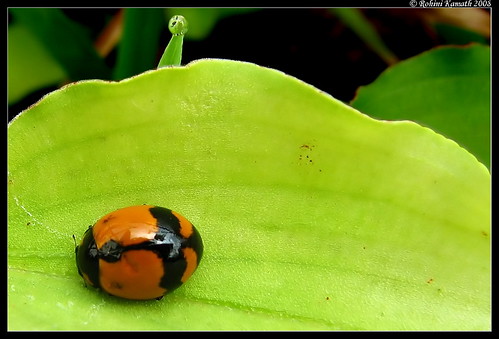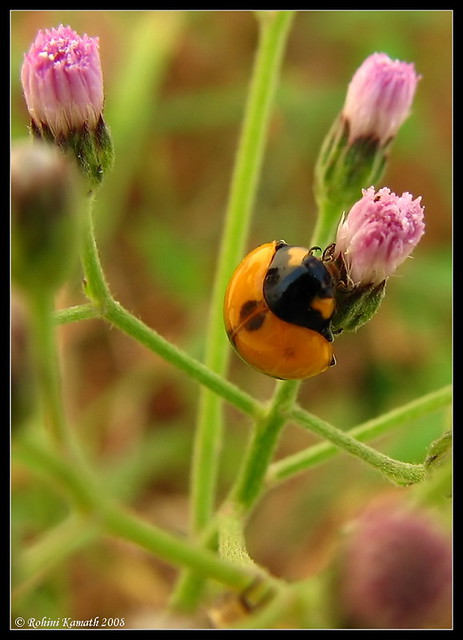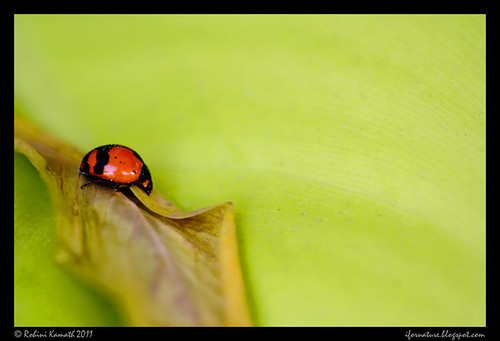
Image from last week - sigma macro 150mm lens - tripod
But first, to more recent images; this one is a first for this blog - a Critter post. Presenting the world's favorite beetle - The LadyBird. We had a few visitors last week which I found among the sofa cushions in the morning. The resulting impromptu photo-shoot made Keshav and I late for work.
A little research to Id my new friends ( they are living in one of my plants now ) led to a wealth of such astonishing information, that I just had to write a post and share it with all who are willing to listen.
Some weird trivia that you never knew about LadyBirds:
Warning: If you are not 18 and above, read no further :)
1. They are perhaps the only species on earth whose male individuals are capable of ejaculating on average 2–3 times per copulation.
2. They can copulate for 9 hours straight, experiencing several orgasms, each lasting up to 30 minutes!
3. ladybirds also sadly suffer from an STD epidemic caused by a parasite
So, now that I've got your attention, we can move on to more mundane info.
The Name - is it ladybird or ladybug?
As it turns out, its actually the Lady Beetle or Ladybird beetle. Because ladybirds are not "true bugs" or Hemiptera. ( To learn more about Hemiptera click here )
They are Coccinellidae. The name originates from Britain ( for the Seven Spot Lady Bird ) called Our Lady's Bird, because of depictions of Mary the mother of Christ wearing a Red Cloak. The Seven spots representing her "seven joys and sorrows".

Archive photo from 2008 - ladybird in dormant state - head retracted
Aphid Hunter
Most Ladybirds are beneficial insects ( i.e beneficial to humans, gardeners and farmers ), they are natural predators of the dreaded aphids. My new friends have been made allies in my long running war with my balcony's aphid population.
My ladybirds seem to be : Coccinella transversalis Fabricius
or the Transverse Ladybird.
They are active July - November in South India. I suspect their early arrival coincides with the daily rains we have been having lately. For some details you can visit aphidweb.
Diet
A normal ladybird diet consists of "pest" insects and their eggs, mildew and pollen.
They have also been known (rarely) to resort to cannibalism.
Like humans, ladybirds are active during the day and go to sleep at night.
Self Defense
1. The bright colour ( red, orange and yellow ) is a sure giveaway; indicating to most predators that ladybirds are not good to eat.
2. They can play dead - I've seen this just once a few days ago when I encountered a ladybird which I collected as our maid was sweeping. It seemed dead at the time, I moved it to a pot in the balcony and checking back an hour later, it was up and about!
3. Smell and taste - they secrete a foul tasting/smelling fluid - Im happy to say Ive not encountered it yet.
4. They have mandibles - i.e they can bite.
Ive found them quite willing to be friends, moving them from the sofa to a pot outside required a dried periwinkle leaf as transport and very little persuasion.

Archive photo from 2008 in our old garden
Basic Anatomy
We aren't going into details here, but the most important word here is elytra. That's the hard colored and spotted shell of the ladybird. It conceals the wings beneath which are fully see-through.
The Pronotum - this is the cover that protects the head of the ladybird, it is capable of retracting its head under this cover like a turtle.
Like all insects they have six legs, but their legs have organs which can smell!

Image from last week - sigma macro 150mm lens - tripod
Lifecycle
They are quick little critters when it comes to growing up. From egg laying, it takes them just 5 days to hatch into larvae. In the larval stage they are as ugly as ugly can get, but be patient. Larva eat aphids too, so they may be ugly but they still do the job. 2-3 weeks and many aphid dinners later, they are ready to pupate into their cute adult forms.
Being a good Host
Ok, so they are cute, friendly and useful; not to mention photogenic. How can you get more of them?
They are attracted to Marigolds ( this is easy to get hold of in India, and grows like a weed ), Cosmos, Mustard and Dill. Plant them and wait for the rainy season.
FYI: I have a small collection of baby marigolds currently flowering. I'm planning to plant cosmos soon, once I get hold of an empty pot.
In-case you were wondering, LadyBirds can live for 2-3 years.
Aside:
Yes! we have acquired new lenses! Keshav's macro lens is taking some getting used to. Handheld is impossible and its pretty heavy too. A little 50mm for me will be showcased in the next critter post shortly!
Sources and further reading:
Aphid Web
SexLife of LadyBirds
The Independent News
Everything Ladybug
Wikipedia






3 comments:
Hi Rohini,
Loved your write up about the Lady Bird.. Your photographs are stunning.. Would appreciate if you can tell me about the camera used..
Hey Anonymous,
Camera used for first and last photo is Canon 350D. The archive photos ( 2nd and 3rd) are from Canon Powershot S3IS.
Nice detailed writeup & stunning photos..
Post a Comment
Please do not post ADs here, they will not be published. All comments are moderated.